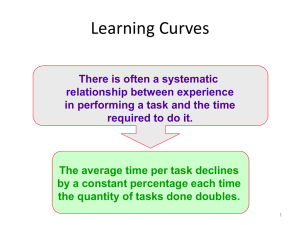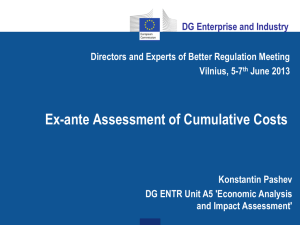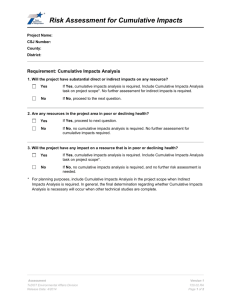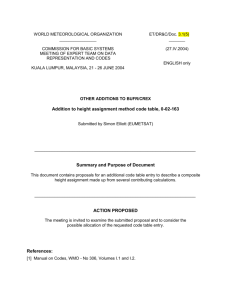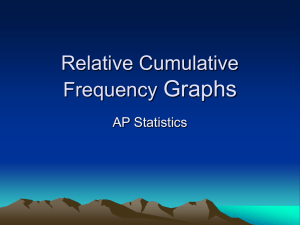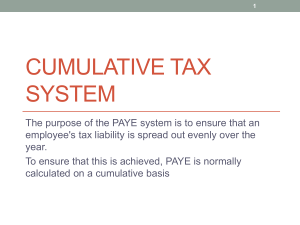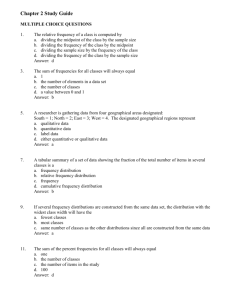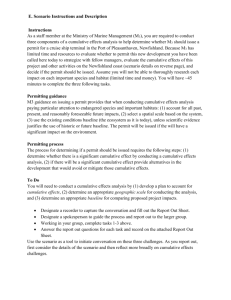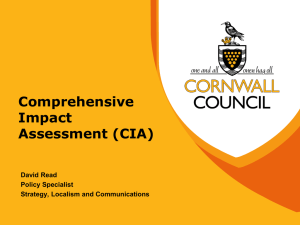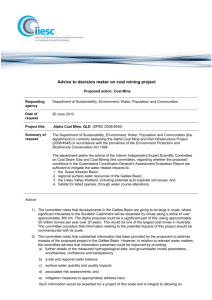World Bank Annual Meeting Policy Forum – October 10 th , 2013
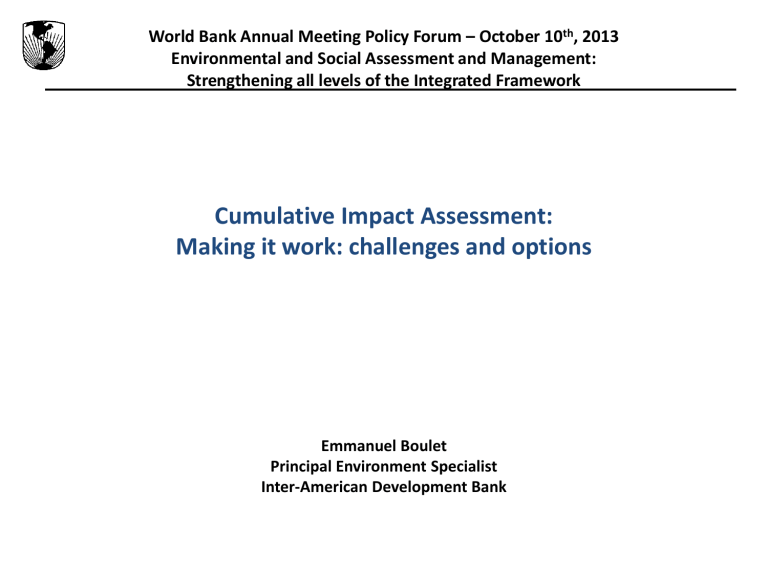
World Bank Annual Meeting Policy Forum – October 10 th , 2013
Environmental and Social Assessment and Management:
Strengthening all levels of the Integrated Framework
Cumulative Impact Assessment:
Making it work: challenges and options
Emmanuel Boulet
Principal Environment Specialist
Inter-American Development Bank
Assessment methodologies are well established…
• General consensus on needs and definition
• Address “blind spots” of the project-focused ESIA process
• Definition e.g. “changes to the environment that are caused by an action in
combination with other past, present and future actions”(Hegman et al.)
• Methodologies exist and their value is proven
Identify the Valued Ecosystem Components (VECs)
Consult stakeholders on VECs and agree on key ones
Define the geographical and temporal scale
Build scenarios and assess impacts of each scenario on key VECs (VECcentered perspective)
Identify impact and risks mitigation strategies following the mitigation hierarchy
…but there are challenges to make it work in a project-centered safeguards framework
Roles and responsibilities: attribution of impacts to a specific project is in effect impossible
General attribution methodology considers:
Comparison with/without the Project
Relative contribution of the Project to the resulting cumulative impact
Interdependence of effectiveness of mitigation strategies: considering each project in isolation leads to sub-optimal solutions.
Example: cascade hydropower:
With/without a specific project in the cascade generally does not make a lot of difference to the overall cumulative impact
Cumulative impact >> ∑(project impact): each project can have a small contribution to a resulting significant cumulative impact
Management dilemma: e.g. barrier effect on migratory fish.
Who owns and manages the resulting cumulative impact?
Attribution challenge: Chiriqui Viejo River
Nine hydropower plants are being developed in cascade on the Chiriquí Viejo River, in western Panama.
The tailrace of each project in effect converting the river in a succession of small reservoirs and dewatered stretches.
Consider cumulative impact on the river with/without a specific plant. For each plant.
What are the options or how to make it work ?
Public Sector: appropriate regulatory and institutional framework in place, e.g. for hydropower cascade:
• Planning tools at the river basin scale, e.g. watershed management plan,
• Stakeholders representation, e.g. river basin committees
• Authority which “owns” the cumulative impacts at river basin scale
Lessons learned: Sequencing is important. CIA recommendations are unlikely to be acted upon if the key elements of such framework don’t already exist.
Private Sector: best efforts to engage and contribute to a multi-stakeholder collaborative approach for the implementation of management actions that are beyond the capacity of an individual project proponent
Lessons learned: Requires a champion. Who is willing to own by default the cumulative impact issues ? Often difficult to implement in practice due to the attribution challenge and a “tragedy of the commons” situation.
Synergies public/private: “the Panel finds that this absence of complementarities between public and private sector development efforts is partially responsible for the observed flaws.” (Compliance Review Report of loan 2266/OC-PN “Pando-Monte Lirio
Hydroelectric Power Plant Project).
Another outcome of CIA process: river offset for the
Reventazon Hydropower Project in Costa-Rica
A CIA process was carried out considering all existing and future developments in the Reventazon River basin
Conclusion of the CIA was that cumulative impacts on key VECs (fish, tourism, water quality, etc…) would be significant.
As a consequence of the CIA process, decision was taken in line with the
mitigation hierarchy to develop and implement a river offset: e.g. commitment to leave a free flowing and healthy river system untouched recognizing that cumulative impact on the developed river system can’t be further mitigated.
